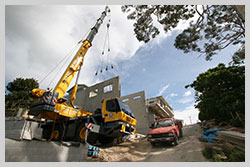
27 Oct Crane Accidents
Crane accidents are serious incidents usually occurring in or near constructions sites. The majority of crane accidents occur as the result of a succession of unfortunate events, so filing an accurate claim against the correct parties can be a complex task.
Causes and Prevention
There are many events that may come into the picture to cause a crane collapse or another type of crane-related accident. Some of those events include but are not limited to:
- Operator error
- Oversight
- Mechanical issues
- Bad luck (yes, this is also a possibility though probably more remote than the others)
It is possible to prevent crane accidents if everyone makes safety a priority. It’s important for employers and workers to engage in effective safety measures throughout every aspect of the job. If an employer fails to properly train a worker, the employer could be found liable for a resulting accident.
Crane Accident Causes and Statistics
According to OSHA, the leading causes of crane accidents are:
- Contact with electrical wires
- Overturns
- Falls
- Mechanical issues
In fact, OSHA reported that eight percent of all fatal construction accidents between 1991 and 2002 were caused by the use of cranes. While these statistics on accidental deaths are alarming, there are also “routine” crane accidents that result in injuries and damages to both the equipment and other property. These accidents can cause a variety of issues including severe personal injury, missed work, fines by OSHA, loss of business opportunities, and much more. OSHA conducted a 3-year study in California in 1997 which showed that most crane accidents were not fatal, and the majority of the injuries did not involve crane operators, but rather other workers.
Safety Standards
Standards related to the design for cranes and hoists are determined by the Crane Manufacturers Association of America. Crane manufacturers must comply with the design specifications as defined in the ASME/ANSI which has specific safety regulations for cranes and hoists. All rigging equipment and related components are required to meet quality standards.
Product Liability
Many crane accidents could have been avoided if the equipment in use had been manufactured in accordance to the prescribed industrial design and production standards. Those who are responsible for manufacturing cranes and hoists must ensure that their equipment does not contain any design or manufacturing defects. If they fail to meet these standards, and an accident occurs, they can be held responsibility under product liability laws. Construction companies are also advised to have workers comp insurance coverage to ensure they are protected in case accidents like this happen.
Making a claim for damages and compensation under product liability is best accomplished by hiring a lawyer competent and experienced in litigating crane accidents. Of course, not all injuries (fatal or otherwise) will involve product liability. Some may be the fault of the construction company, the failure of the operator to exercise proper safety precautions, or simply a “freak” accident. However, when the liability is that of a third party, an experienced workers compensation lawyer or a professional social security disability lawyer can help you receive the compensation you deserve.









Sorry, the comment form is closed at this time.